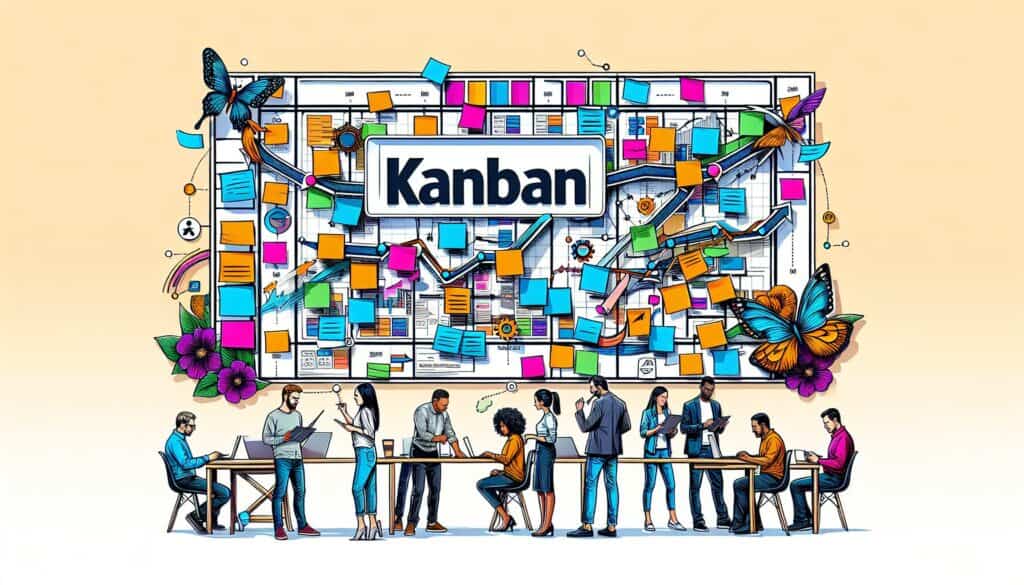A visual workflow management method designed to help teams visualize their work, limit work-in-progress (WIP), and maximize efficiency (or flow).
- Methodologien: Kunden & Marketing, Ideenfindung, Produktdesign
Kanban

Kanban
- Agile Methodik, Kontinuierliche Verbesserung, Kanban, Schlanke Fertigung, Prozessverbesserung, Projektmanagement, Teamarbeit, Wertstrom-Mapping
Zielsetzung:
Wie es verwendet wird:
- Work items are represented by cards on a Kanban board, which is divided into columns representing stages of the workflow. Teams pull work from one stage to the next as capacity allows, with explicit WIP limits for each stage to prevent bottlenecks.
Vorteile
- Improves workflow visibility and transparency; Helps identify bottlenecks quickly; Flexible and adaptable to various processes; Promotes continuous flow and reduces lead times by limiting WIP.
Nachteile
- Does not inherently provide time estimations for tasks; Can be less effective if WIP limits are not respected or if tasks are not broken down appropriately; Requires team discipline and commitment to the system.
Kategorien:
- Ideenfindung, Lean Sigma, Herstellung, Produktdesign, Projektmanagement
Am besten geeignet für:
- Managing and improving workflows, especially for teams with a continuous flow of tasks or in operational environments.
Kanban methodology is effectively utilized across a wide range of industries such as software development, manufacturing, healthcare, and logistics, where managing continuous workflows is imperative. For example, in software teams, Kanban boards can visualize features being developed, tested, and deployed, which allows for real-time adjustments based on the team’s workload and priorities. In operational environments, such as factories, Kanban can facilitate inventory management, ensuring that supplies move smoothly through production lines by aligning supply with demand. This methodology can be implemented during various project phases, from initial conception to ongoing maintenance, and is beneficial for cross-functional teams including designers, engineers, and product managers who need to collaborate effectively. The initiation of a Kanban system often involves team leaders or project managers who establish the framework, while all team members participate in updating and managing the board, ensuring that work remains visible and that responsibilities are shared. With defined Work In Progress (WIP) limits, the Kanban approach encourages teams to concentrate on completing tasks before taking on new ones, mitigating the risk of overload and enhancing focus on delivering quality outcomes. Regular reviews can identify bottlenecks, allowing for timely interventions that drive process improvement, making Kanban a versatile tool for enhancing team productivity and operational efficiency.
Die wichtigsten Schritte dieser Methodik
- Visualize the workflow by creating a Kanban board with columns for each stage of the process.
- Define work item types and assign tasks to cards that represent these items.
- Set explicit Work In Progress (WIP) limits for each column to control flow and prevent bottlenecks.
- Implement a pull system where team members pull tasks from the previous column as capacity allows.
- Monitor and manage flow by adjusting WIP limits and making process improvements based on observed performance.
- Conduct regular reviews and stand-up meetings to discuss progress, challenges, and potential adjustments.
- Create feedback loops to enable continuous improvement, adapting the board and workflows as necessary.
Profi-Tipps
- Regularly conduct retrospective reviews to refine WIP limits and ensure they reflect actual team capacity and workflow efficiency.
- Utilize metrics such as cycle time and lead time to make data-driven adjustments to the Kanban board and improve throughput.
- Implement "swimlanes" on the Kanban board to categorize work items by type, priority, or team role, enhancing visibility and focus on critical tasks.
Verschiedene Methoden lesen und vergleichen, Wir empfehlen die
> Umfassendes Methoden-Repository <
zusammen mit den über 400 anderen Methoden.
Ihre Kommentare zu dieser Methodik oder zusätzliche Informationen sind willkommen auf der Kommentarbereich unten ↓ , sowie alle ingenieursbezogenen Ideen oder Links.
Historischer Kontext
1930
1940
1950
1950
1958
1960
1960
1930
1940
1949
1950
1950
1960
1960
1960
(wenn das Datum nicht bekannt oder nicht relevant ist, z. B. "Strömungsmechanik", wird eine gerundete Schätzung des bemerkenswerten Erscheinens angegeben)















Verwandte Artikel
Master Production Schedule (MPS)
Massenanpassung
Marketing-Trichter
Marketing-Audit
MAPO-Index (Bewegung und Unterstützung von Krankenhauspatienten)
Fertigungsressourcenplanung (MRP II)